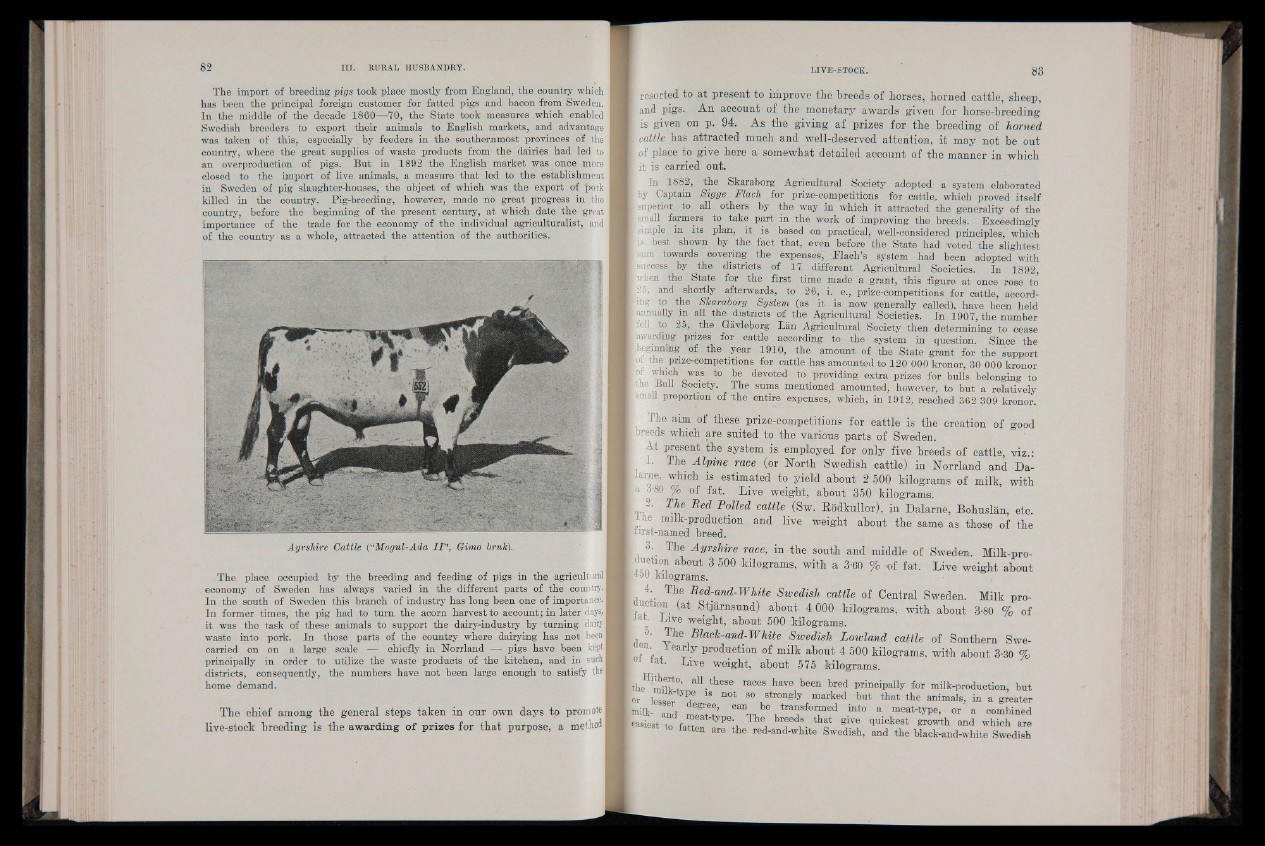
The import of breeding pigs took place mostly from England, the country which
has been the principal foreign customer for fatted pigs and bacon from Sweden.
In the middle of the decade 1860— 70, the State took measures which enabled
Swedish breeders to export their animals to English markets, and advantage
was taken of this, especially by feeders in the southernmost provinces of the
country, where the great supplies of waste products from the dairies had led to
an overproduction of pigs. But in 1892 the English market was once more
closed to the import of live animals, a measure that led to the establishment
in Sweden of pig slaughter-houses, the object of which was the export of £ork
killed in the country. Pig-breeding, howeveT, made no great progress in the
country, before the beginning of the present century, at which date the great
importance of the trade for the economy of the individual agriculturalist, and
of the country as a whole, attracted the attention of the authorities.
Ayrshire Cattle (“Mogul-Ada I I ”, Qimo bruk).
The place occupied by the breeding and feeding of pigs in the agricultural
economy of Sweden has always varied in the different parts of the country.'
In the south of Sweden this branch of industry has long been one of importance.:
In former times, the pig had to turn the acorn harvest to account; in later days,
it was the task of these animals to support the dairy-industry by turning dairy
waste into pork. In those parts of the country where dairying has nombeei
carried on on a large scale — chiefly in Norrland — pigs have been kept:
principally in order to utilize the waste products of the kitchen, and in sucl^
districts, consequently, the numbers have not been large enough to satisfy the.
home demand.
The chief among the general steps taken in onr own days to promote
live-stock breeding is the aw a rd in g o f p r iz e s for that purpose, a method
resorted to at present to improve the breeds of horses, horned cattle, sheep,
and pigs. An account of the Monetary awards given for horse-breeding
is given on p. 94. As the giving af prizes for the breeding of horned
cattle has attracted much and well-deserved attention, it may not be out
of place to give here a somewhat detailed account of the manner in which
fit is carried out.
In 1882, the Skaraborg Agricultural Society adopted' a system elaborated
by Captain Sigge Flach for prize-competitions for cattle, which proved itself
superior to all others by the way in which it attracted the generality of the
small farmers to take part in the work of improving the breeds. Exceedingly
simple in its plan, it is based on practical, well-considered principles, which
s best shown by the fact that, even before the State had voted the slightest
sum . towards covering the expenses, Elach’s system had been adopted with
success by the districts of 17 different Agricultural Societies. In 1892,
/hen the State for the first time made a grant, this figure at once rose to
(25, and shortly afterwards, to 26, i. e., prize-competitions for cattle, accord-
% to the Skaraborg System (as it - i s now generally called), have been held
innually m all the districts of the Agricultural Societies. In 1907, the number
[fell to 25, the Gavleborg Lan Agricultural Society then determining to cease
awarding prizes for cattle according to the system in question. Since the
beginning pf the year 1910, the amount of the State grant for the support
af the prize-competitions for cattle has amounted to 120 000 kronor, 30 000 kronor
f which was to be devoted to providing extra prizes for bulls belonging to
the Bull Society. The sums mentioned amounted, however, to but a relatively
fsmall proportion of th e entire expenses, which, in 1912, reached 362 309 kronor.
The aim of these prize-competitions for cattle is the creation of good
[breeds which are suited to the various parts of Sweden.
At present the system is employed for only five breeds of cattle, viz.:
1. The Alpine race (or North Swedish cattle) in Norrland and Da-
llarne, which is estimated to yield about 2 500 kilograms of milk, with
a 3-80 % o f fat. Live weight, about 350 kilograms.
IL.”"' Red Pnlled cattle (Sw- Rddkullor), in Dalarne, Bohuslan, etc.
( I he milk-production and live weight about the same as those of the
[lirst-named breed.
3. The Ayrshire race, in the south and middle of Sweden. Milk-pro-
[duction about 3 500 kilograms, with a 3-60 % of fat. Live weight about
|4:0U kilograms.
4. The Red-and-White Swedish cattle of Central Sweden. Milk pr0-
uc ion (at Stjarnsund) about 4 000 kilograms, with about 3-80 % of
! a * ve weight, about 500 kilograms.
dp5 Placlc~arid-Whtte Swedish Lowland cattle of Southern Swei
f « , * y pr0liuctio11 of milk about 4 500 kilograms, with about 3-30 %
tat. Live weight, about 575 kilograms.
'the Q f l a ll. these races have been bred principally for milk-production, but
for le s s£ d “ DOt S° Lstrollgly marked but ^ a t the animals, in a greater
milk- and transformed into a meat-type, or a combined
[easiest to fstt A , ® ,S at glve quickest growth and which are
o fatten are the red-and-white Swedish, and the black-and-white Swedish